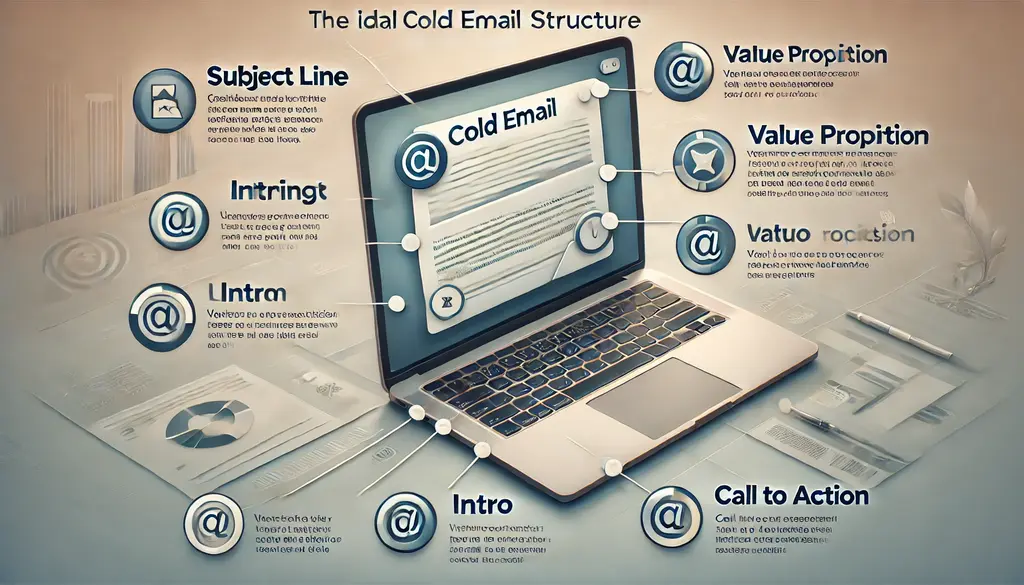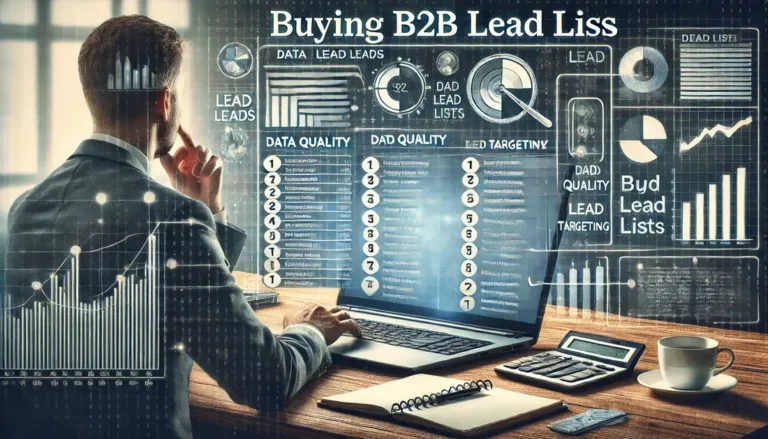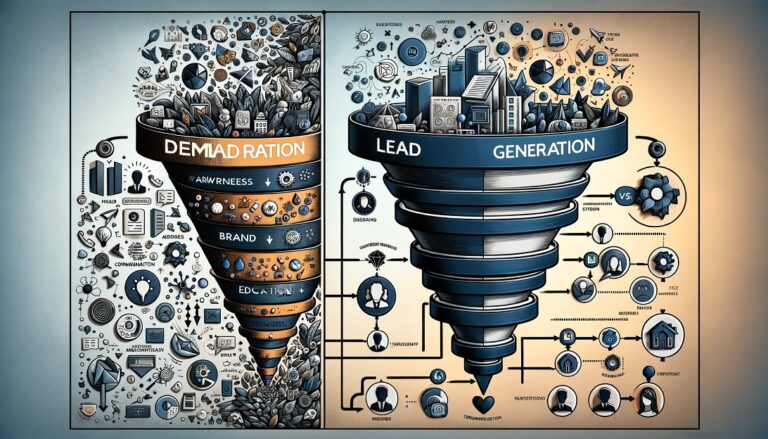For businesses, communication is everything. And while there are many ways to communicate, cold emailing remains one of the most effective tools for reaching out to potential clients, partners, or customers. But let’s face it: not all cold emails are created equal. Some get opened, read, and replied to, while others are swiftly deleted or, worse, marked as spam. So, what makes the difference? The answer lies in how the ideal cold email structure works.
In 2024, with increased competition and ever-evolving digital marketing trends, understanding the ideal structure for a cold email is more important than ever. Let’s dive into the details.
Why Structure Matters in Cold Emails/
Think of a cold email as your first impression of a potential lead. If it’s not clear, engaging, and well-organized, you’ve lost the opportunity before you even begin. Cold emails are designed to grab attention and prompt action, but the recipient has to understand your message quickly. Poorly structured emails look cluttered, overwhelming, and unprofessional, leading to lower response rates.
On the other hand, a well-structured email guides the reader smoothly from one point to the next, making your intent crystal clear and increasing the chances of a positive reply.
In 2024, with AI filters, spam blockers, and more competitive marketing landscapes, businesses need to focus on making their cold emails stand out by being strategic, relevant, and well-organized. This means not just saying the right thing, but saying it in the right way.
Key Elements of an Ideal Cold Email Structure
Subject Line: The First Thing They See
Your subject line is the gateway to your email. It is the first thing your recipient sees and often determines whether they will open the email at all. A successful subject line is concise, catchy, and relevant. It needs to hint at the content inside without giving everything away, and it should make the recipient curious enough to click.
Keep it short, ideally between 2-6 words, and aim for personalization. Adding the recipient’s name or a specific detail relevant to them can significantly increase open rates. Also, avoid overly sales-driven language, as it can lead to your email being marked as spam. Instead, focus on how you can add value or solve a problem.
Example: “Boost Your Marketing ROI – Here’s How”
Greeting: A Personalized Touch
The greeting is where you start setting the tone for your email. Generic salutations like “Dear Sir/Madam” or “To Whom It May Concern” feel impersonal and can be a turnoff for many readers. Instead, opt for a personalized greeting that uses the recipient’s name. Addressing someone by name shows that you’ve taken the time to research them and adds a personal touch that can make a big difference.
For an even more tailored approach, consider the recipient’s background, culture, or language when choosing your greeting. If you know their preferred name or nickname, use it. Keep the tone friendly and professional to create a sense of familiarity and trust from the start.
Example: “Hi Sarah,” or “Good morning, John,”
Intro or Icebreaker: Setting the Scene
The introduction is your opportunity to capture the reader’s attention immediately. It should be quick and compelling, providing a reason for them to keep reading. A personalized statement or a short compliment works well here. Whether it’s mentioning a recent achievement of theirs, a shared connection, or a relevant industry trend, the key is to make it clear that this email is intended for them, not a bulk message.
This icebreaker not only helps to set a friendly tone but also builds rapport. Remember, if you want your email to get a response, you need to engage the reader from the first line.
Example: “I came across your recent article on digital marketing trends, and I was impressed by your insights, especially on content automation.”
Reason for Outreach: Why Are You Writing?
Once you’ve grabbed their attention, it’s time to get to the point. Be clear about why you’re reaching out and do it quickly. The recipient should understand within the first few seconds what this email is about. If you’re introducing a product, suggesting a partnership, or proposing a solution, make sure you state it directly. Keep this part short and avoid jargon.
Make sure your reason is aligned with the recipient’s needs. The more specific and relevant you can be, the better. If possible, mention a pain point they might have or a challenge they are facing, and hint at how you can help.
Example: “I’m reaching out because I believe our latest software can streamline your project management processes and save your team hours each week.”
Value Proposition: What’s In It for Them?
This is the most critical part of your email. It’s where you need to explain, clearly and concisely, the benefits you bring to the table. Why should the recipient care? What problem do you solve? How do you add value? Your value proposition should be specific, focusing on one or two key benefits that directly address a challenge or opportunity for the recipient.
Use concrete examples or metrics if possible. Instead of vague promises, offer proof. Briefly mentioning other clients you’ve helped or results you’ve achieved can add credibility to your claims. But keep it concise; you want them to be intrigued, not overwhelmed.
Example: “Our platform has helped companies like XYZ reduce their email marketing costs by 30% while increasing their open rates by 20%.”
Call to Action (CTA): Guiding Them to the Next Step
Every cold email should have a clear call to action. After reading your email, the recipient should know exactly what you want them to do next. Whether it’s scheduling a call, clicking a link, or responding with a piece of information, make sure your CTA is straightforward and easy to follow.
Avoid multiple calls to action, as this can confuse the reader. A single, well-placed CTA is more effective. Also, don’t push too hard; the request should be reasonable and low-friction. For example, asking for a brief 10-minute call is more inviting than requesting an hour-long meeting.
Example: “Would you be open to a quick 15-minute chat next week to see how we can help your team achieve similar results?”
Closing and Sign-off: Wrapping It Up
A well-thought-out closing leaves a positive impression. The tone should be polite, professional, and optimistic. End with a simple, respectful line that matches the overall tone of the email. You can add a P.S. line for a final touch of personalization or to reiterate a key point.
Sign-offs like “Best regards” or “Sincerely” are safe, professional options. Choose what fits best with your brand voice and the context of your email.
Example: “Looking forward to your response. Warm regards, [Your Name]”
Signature: Professional and Informative
Your signature should contain all the necessary information for the recipient to know who you are and how to reach you. Include your full name, position, company, and contact details. If relevant, you can add a link to your website, portfolio, or social media profiles. This not only adds to your credibility but also makes it easier for recipients to learn more about you and your organization.
Example:
Jane Doe
Marketing Director, XYZ Corp
www.xyzcorp.com | (123) 456-7890
Additional Elements for a Strong Cold Email
A great cold email is more than just the sum of its parts. Consider factors like email length, design, and the use of links and attachments.
Email Length: Keep it short and to the point. Busy professionals don’t have time to read lengthy emails, so aim for around 100-200 words. Every word should serve a purpose, and there should be no fluff.
Visual Elements: While plain text is usually best for cold emails, a subtle use of visuals can make your message stand out. Just be mindful not to overdo it, as too many images or GIFs can lead to your email being marked as spam.
Use of Links and Attachments: Limit links to one or two, and avoid adding attachments unless absolutely necessary. Emails with too many links can look spammy, and attachments might be blocked by email providers or ignored by the recipient.
Best Practices for Cold Emails in 2024
In 2024, personalization, relevance, and compliance are the three pillars of successful cold emailing. Each email should feel like it was crafted specifically for the recipient, not a generic message sent out to hundreds of people. This requires research and effort but makes a significant difference in response rates.
Ensure you are compliant with email regulations like GDPR and CAN-SPAM to avoid legal issues. Also, keep refining your approach based on feedback and testing different strategies to see what works best for your audience.
Common Mistakes to Avoid
Some common pitfalls include using clickbait subject lines, writing overly aggressive or sales copy, and ignoring follow-ups. Avoid being vague or pushy, as this can turn off potential leads. If your first attempt doesn’t get a response, consider sending a polite follow-up after a few days.
Examples of Effective Cold Email Templates
Having a few templates can save time and provide consistency. For example, a general sales outreach email might begin with a value proposition followed by a strong CTA, while a networking email could start with a personal compliment. The key is to adapt each template to fit the specific recipient, ensuring a personalized touch.
Using AI Tools for Better Email Structuring
AI can be a game-changer for cold email campaigns. With AI-powered tools, you can personalize emails at scale, automate follow-ups, and analyze performance to optimize your outreach. These tools can save time and help you focus on crafting the best possible message.
Using AI Tools for Better Email Structuring
AI tools have revolutionized cold emailing by allowing for mass personalization, automated follow-ups, and performance analysis. These tools can help businesses scale their outreach without sacrificing quality. Consider using AI-powered solutions to improve your efficiency and focus on building stronger connections.
How AI Helps with Cold Emails?
AI has transformed how businesses approach cold emailing, offering a range of tools to enhance efficiency, personalization, and effectiveness. Here’s how AI can make a difference:
1. Personalization at Scale: AI can analyze recipient data, including past interactions, job roles, and preferences, to create tailored email content. It helps craft personalized greetings, subject lines, and introductions that feel relevant, increasing engagement.
2. Automated Follow-Ups: Following up is crucial in cold emailing. AI tools can schedule and automate follow-up emails based on recipient behavior, such as not opening or responding to the initial email. This ensures consistent engagement without manual effort.
3. Subject Line Optimization: AI can test and suggest subject lines by analyzing what resonates best with recipients, helping improve open rates. Machine learning algorithms can identify patterns that increase effectiveness, offering data-driven recommendations.
4. Content Generation and Enhancement: AI can assist in writing email drafts by generating content that aligns with the goals of the outreach. By using natural language processing (NLP), AI tools can create concise, engaging, and grammatically correct emails. They can also suggest improvements, making sure your message is clear and persuasive.
5. Analytics and Insights: AI-powered analytics tools can track the performance of email campaigns, providing insights on open rates, click-through rates, and conversion metrics. This helps businesses refine their strategies by understanding what works and what doesn’t. AI can even predict the best times to send emails for maximum impact.
6. Spam Detection and Compliance: AI can analyze emails to ensure they avoid words or structures that might trigger spam filters, increasing the chances of delivery. Additionally, it can help monitor compliance with regulations like GDPR and CAN-SPAM by automatically checking for required opt-out options and privacy statements.
7. Language and Tone Adjustment: AI tools can adjust the tone of emails to fit the audience, ensuring that the communication feels appropriate. For instance, it can make the language more formal or casual based on the recipient’s profile.
Conclusion
Crafting the perfect cold email in 2024 requires a combination of clarity, personalization, and strategic structuring. By following the ideal structure and focusing on what matters most to the recipient, you can significantly improve your chances of making a meaningful connection. Always be ready to refine your approach based on feedback and adapt to the changing dynamics of digital communication. With the right structure, a cold email can be a powerful tool for building relationships and driving business success.








